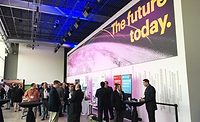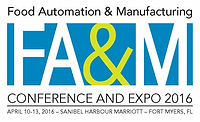How food and beverage companies can be faster and more flexible in the future
At its annual US Innovation Day, Siemens puts digital transformation tools on display.

If the craft beer boom has taught the food and beverage anything, it is that consumers are willing to pay more for what they consider higher quality products. And for companies looking to attract new consumers who are demanding fresher and healthier food and beverages, Ryan Jarvis, head of Siemens’ food and beverage vertical, says digital manufacturing tools can help them bring the next big thing to market faster and more efficiently.
“The farm to fork scenario is very much (based) on quality,” he says. “It’s important to consumers to know that the dairy product in their health bars came from Smith Dairy two counties over…and digitalization is what is going to enable that.”
From providing transparency and traceability to speeding up and reducing costs in the product and production planning process, these are just some of the capabilities of the Siemens’ solutions demonstrated at the company’s annual US Innovation Day, on March 27 at the Digital Manufacturing and Design Innovation Institute (DMDII) in Chicago.
“Food and beverage is really driven by what consumers want and what they expect,” Jarvis says. “There is so much opportunity for modernization in this industry because there are a lot of older assets out there.”
With many bigger food and beverage companies struggling with having legacy plants that might employ older systems and equipment, it can be a struggle to keep up with changing market needs and demands.
“At Siemens, we look at what we can do across the digital enterprise with simulation and validation, auto generation of the code and configuration and push that onto the plant floor,” Jarvis says. “Whereas historically, you could spend man-weeks or man-months developing the code and the processes and testing…plus, there’s the onsite startup complexity—integrating equipment from 10 or 15 different OEMs and sequencing it. All that can be negated with the virtual world that we bring to the table.”
Siemens uses the term digital twin to refer to the simulation of a product and its production in the virtual world, so that it can be more accurately produced in the real world.
“In the virtual world, you can try everything out. You can identify and correct the inefficiencies and the gaps and the integration challenges, so that when it hits the plant floor and its crunch time to get products to market, that timeframe is collapsed,” Jarvis says.
Plus, he says because the code can be automatically generated from the digital twin and enters into physical world by pushing it to PLCs and drives, this frees up engineers from having to do tedious work and allows them to think more conceptually.
“One of the things that Siemens does that is very unique is that we do the virtual and physical world like no one else can,” says Jarvis.
The Innovation Day also included presentations on Siemens’ real-world applications of digital solutions in other industries such as energy, automotive and building management.
“With the arrival of the Internet of Things in industry and infrastructure, many organizations are still trying to understand how to incorporate digital strategies into their business models,” said Roland Busch, chief technology officer and member of the managing board of Siemens AG. “Siemens has reinvented itself into one of the world’s top 10 software companies and is continuing to expand its digital capabilities.”
Siemens says it has created 20 centers, called MindSphere Application Centers, in 17 different countries to co-create intelligent solutions with customers. About 900 software developers, data specialists, and engineers are working with Siemens customers at these centers to develop digital innovations for data analysis and machine learning. These new solutions are being developed on MindSphere, Siemens’ open, cloud-based operating system for IoT.
“With our MindSphere Application Centers, we’re combining deep expertise in automation and electrification with our unique industrial software offering to enable our customers to leverage digital solutions for their specific needs,” says Busch.
Approximately one million devices and systems are now connected via MindSphere, and the company says this figure will reach 1.25 million by the end of fiscal 2018.
About UI LABS and DMDII
UI LABS was formed to bring universities, industry and civic organizations together to drive innovation and tech-based economic development in the Midwest. The organization opened nearly 100,000 square feet of demonstration and collaboration space in Chicago in May 2015. Since then, more than 300 partners from industry, academia and government have joined the organization.
UI LABS’ primary mission is to transform industries using digital technologies, and one of its platforms, the DMDII, focuses on how manufacturing will change in the next few years. DMDII functions as a world-class, first of its kind manufacturing hub that is designed to provide US factories the tools, software and expertise they need to manufacture more efficiently in order for US companies to compete on the world stage.
Looking for a reprint of this article?
From high-res PDFs to custom plaques, order your copy today!







